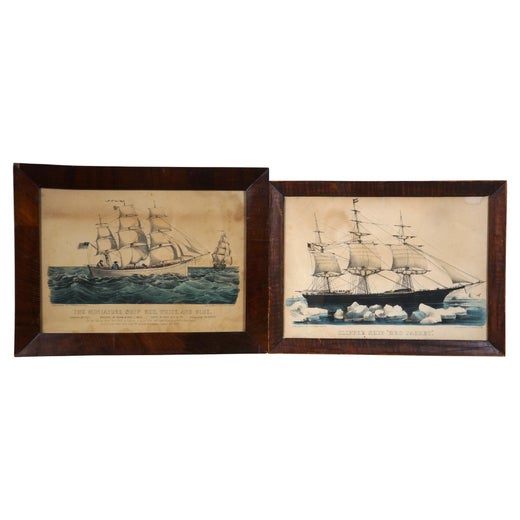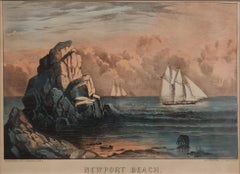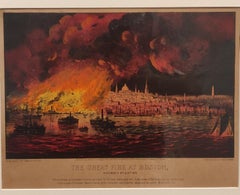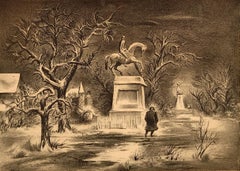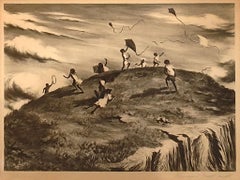Want more images or videos?
Request additional images or videos from the seller
1 of 4
Currier & Ives"The Burning of Chicago" Currier and Ives, Water and Urban Landscape Print1871
1871
Price:$1,200
About the Item
- Creator:Currier & Ives (1834 - 1907, American)
- Creation Year:1871
- Dimensions:Height: 7.31 in (18.57 cm)Width: 12.68 in (32.21 cm)
- More Editions & Sizes:PrintPrice: $1,200
- Medium:
- Movement & Style:
- Period:
- Framing:Framing Options Available
- Condition:
- Gallery Location:New York, NY
- Reference Number:1stDibs: LU1841214417582
Currier & Ives
Currier and Ives was a prominent American printmaking establishment headquartered in New York operating from 1835 to 1907. Nathaniel Currier (1813-1888) started his business on his own, but later merged with James Merritt Ives (1824-1895), becoming "Currier and Ives" in 1857. They produced and sold hand-colored lithographs which could be produced relatively quickly and cheaply. They called themselves "the Grand Central Depot for Cheap and Popular Prints". The company published around 7,500 lithographs in its 72 years in business.
About the Seller
5.0
Platinum Seller
Premium sellers with a 4.7+ rating and 24-hour response times
Established in 2022
1stDibs seller since 2022
122 sales on 1stDibs
Authenticity Guarantee
In the unlikely event there’s an issue with an item’s authenticity, contact us within 1 year for a full refund. DetailsMoney-Back Guarantee
If your item is not as described, is damaged in transit, or does not arrive, contact us within 7 days for a full refund. Details24-Hour Cancellation
You have a 24-hour grace period in which to reconsider your purchase, with no questions asked.Vetted Professional Sellers
Our world-class sellers must adhere to strict standards for service and quality, maintaining the integrity of our listings.Price-Match Guarantee
If you find that a seller listed the same item for a lower price elsewhere, we’ll match it.Trusted Global Delivery
Our best-in-class carrier network provides specialized shipping options worldwide, including custom delivery.You May Also Like
Railroad, 1932, Reginald Marsh, Train, Lithograph, Metropolitan Museum of Art
By Reginald Marsh
Located in Wiscasset, ME
An urban realist painter, Marsh was born in Paris, France and began drawing as early as the age of three. His artistic studies were done at Yale University, the Art Student League in New York and in Paris. Marsh was a member of the National Academy, the Royal Society of Artists, London, the Southern Vermont Artists...
Category
1930s Realist Landscape Prints
Materials
Lithograph
$1,600
H 6.75 in W 9.88 in
HARBINGER OF SPRING Signed Lithograph, Farm House Landscape Blue Sky White Barn
By Mel Hunter
Located in Union City, NJ
HARBINGER OF SPRING is an original limited edition, hand drawn lithograph(not a photo reproduction or digital print) by the American artist/illustrator Mel Hunter, printed using hand...
Category
1970s Realist Landscape Prints
Materials
Lithograph
$360 Sale Price
48% Off
H 21.75 in W 29.75 in
LITTLEWOODS Signed Lithograph, Historic Stone Farmhouse, Bucks County Landscape
By Peter Sculthorpe
Located in Union City, NJ
LITTLEWOODS is an original hand drawn, limited edition lithograph by Peter Sculthorpe (b.1948 Ontario, Canada) printed using hand lithography techniques on archival Arches paper, 100...
Category
1980s Realist Landscape Prints
Materials
Lithograph
COOPER'S RAINBOW Signed Lithograph, Farm Landscape, Horses, Golden Field, Barn
By Wayne Cooper
Located in Union City, NJ
COOPER'S RAINBOW is an original, hand drawn, limited edition lithograph by the American painter Wayne Cooper printed in NYC using traditional hand lithogr...
Category
1970s Realist Animal Prints
Materials
Lithograph
"de poort" - Landscape with Trees & Art Nouveau Gate, Limited Edition Lithograph
By David Corbett
Located in Soquel, CA
Limited edition lithograph featuring an ornate, Art Nouveau style gate in a wintry landscape with bare trees on the horizon by David Corbett (American, 20th Century). Numbered, title...
Category
Late 20th Century Realist Landscape Prints
Materials
Paper, Ink, Lithograph
$380 Sale Price
20% Off
H 15 in W 12 in D 0.07 in
Original Images Geographiques vintage French poster on linen
Located in Spokane, WA
Images Géographiques (c. 1900). Tanconville.
Original French Lithographic Poster — Linen-Backed, Restored. Size: 41.5” x 29”
Capture the spirit of the Belle Époque with this turn...
Category
1890s Realist Landscape Prints
Materials
Lithograph
$675
H 41.5 in W 29 in D 0.3 in
John Nash RA - Harvesting - Schools Print - 20th Century British lithograph
By John Nash
Located in London, GB
JOHN NASH, RA
(1893-1977)
Harvesting
Lithograph
Framed
49 by 75 cm., 19 ¼ by 29 ½ in.
(frame size 65 by 91.5 cm., 25 ½ by 35 ½ in.)
On the advice of his older brother, the artist...
Category
Mid-20th Century Realist Landscape Prints
Materials
Lithograph
$1,029
H 19.3 in W 29.53 in
colorful landscape abstract Landschaftsszene
By Pawel Kontny
Located in Belgrade, MT
Pawel Kontny was born in Poland, he began with sketching wartime scenes combining abstract with realism. He exhibited throughout Europe. This piece is a part of my private collection...
Category
Mid-20th Century Realist Landscape Prints
Materials
Lithograph
$450 Sale Price
25% Off
H 15 in W 21.5 in
Petra, The Upper or Eastern Valley: 19th C. Hand-colored Roberts Lithograph
By David Roberts
Located in Alamo, CA
This is an original 19th century hand-colored lithograph entitled "Petra, Shewing the Upper or Eastern End of the Valley" by David Roberts, from his Egypt, The Holy Land and Nubia volumes of the large folio edition, published in London by F. G. Moon in 1842. The lithographs were prepared by Louis Haghe (1806-1885) from drawings and paintings by Roberts. The resultant large folio editions of 'The Holy Land' and 'Egypt & Nubia' are considered the greatest lithographically illustrated works issued in the 19th century.
This is one of Roberts' most famous and collectible works. The scene captures a view of the magnificent ruins of Petra in what is Jordan today, as it appeared on March 8, 1839, on the day of Roberts' visit. Multiple Arab men are approaching Petra; some on foot and others riding camels. They are dressed in their colorful local costumes. Roberts' signature and hand written date are reproduced in the plate on the left.
This hand-colored lithograph is printed on wove paper with wide margins. There is some loss of color in the text in the title and a faint dark curvilinear area in the upper right. The print is otherwise in very good condition. It is presented in a gold-colored wood frame with a tan mat. It is glazed with UV protected conservation glass. All framing materials used are archival museum quality. The frame measures 23.5" high and 30.5" wide.
There are two additional iconic David Roberts hand-colored lithographs for sale on 1stdibs that are matted and framed in identical styles, although slightly different sizes. They are scenes of Approach of Simoon, Desert of Gizeh and the Citadel of Cairo. They can be viewed by typing their reference #'s, LU1173211955452 and LU1173211970142, into the 1stdibs search field or typing Timeless Intaglio in the search field and tapping on the drop down name to be taken to our storefront. Two or all three of these pieces would make for a striking display grouping. A discount is available for the purchase of multiple pieces.
David Roberts (1796-1864) was a Scottish painter who specialized in landscapes, architectural subjects, and scenes from the Middle East and Europe. Born in Edinburgh, Roberts began his career at age ten as an apprentice to a house painter and eventually became a scene painter for theater companies in Edinburgh and London. In the 1820s, J. M. W. Turner recognized his artistic talent and encouraged him to become a full-time artist. He began to focus on painting landscapes and architecture. In 1838 he traveled to Egypt and soon after to the Holy Land, concluding in Jerusalem. Roberts' travels in the Middle East had a profound impact on his art, and he produced a series of highly detailed and realistic paintings and sketches of the region's famous ruins and other landmarks, including the Pyramids of Giza, the Sphinx, the Temple of Abu Simbel...
Category
Mid-19th Century Realist Landscape Prints
Materials
Lithograph
$3,575
H 23.5 in W 30.5 in
David Roberts' 19th Century Hand Colored Lithograph, "Fortress of Ibrim, Nubia"
By David Roberts
Located in Alamo, CA
"Approach to the Fortress of Ibrim, Nubia" is a 19th century folio sized hand-colored lithograph from the Egypt and Nubia volume of David Roberts’ large folio edition, published in London by F. G. Moon in 1847. The lithographs were prepared by Louis Haghe (1806-1885) from drawings and paintings by Roberts. The resultant large folio editions of 'The Holy Land' and 'Egypt & Nubia' are considered the greatest lithographically illustrated works issued in the 19th century.
The print is presented in a gold-colored wood frame with a decorative inner trim, with a cream-colored double mat. It is in excellent condition.
The lithograph depicts the Fortress of Ibrim in Nubia in the background, which had been a Roman and an Egyptian fortification for centuries due to its strategic elevation, allowing a view of large portions of the surrounding desert. Men are securing the boat in the foreground for the night, taking down its sails. A herd of cattle drinks and cools themselves in the water on the left.
There are four additional listings of David Roberts engravings of Egypt...
Category
1840s Realist Landscape Prints
Materials
Lithograph
$2,975
H 24.63 in W 31.75 in D 1.25 in
More From This Seller
View All"Newport Beach" Currier & Ives, Hand-Colored Lithograph of Newport Beach
By Currier & Ives
Located in New York, NY
Currier & Ives
Newport Beach
Hand-colored lithograph
Sheet 10 x 13 1/4 inches
After undertaking apprenticeships in Boston and Philadelphia, Currier set up a print publishing compan...
Category
Late 19th Century Realist Figurative Prints
Materials
Lithograph
"The Great Fire of Boston" Currier & Ives, Urban landscape late 19th century
By Currier & Ives
Located in New York, NY
Currier & Ives
The Great Fire of Boston , 1872
Hand-colored lithograph
7 5/16 x 12 11/16 inches
After undertaking apprenticeships in Boston and Philadelphia, Currier set up a print...
Category
1870s Realist Landscape Prints
Materials
Lithograph
"City Park, Winter" Aaron Bohrod, Mid-Century, American Realist Nocturne
By Aaron Bohrod
Located in New York, NY
Aaron Bohrod
City Park, Winter, circa 1945
Signed in pencil lower right margin
Lithograph on wove paper
Image 9 1/2 x 13 1/2 inches
From the edition of 250
Aaron Bohrod's work has ...
Category
1940s American Realist Figurative Prints
Materials
Lithograph, Paper
"Windy Hill" Lawrence Beall Smith, Mid-Century Realist Scene, American Life
By Lawrence Beall Smith
Located in New York, NY
Lawrence Beall Smith
Windy Hill, 1948
Signed in pencil lower right margin
Lithograph on wove paper
Image 10 3/8 x 13 1/16 inches
Sheet 11 15/16 x 16 inches
From the edition of 250
...
Category
1940s American Realist Figurative Prints
Materials
Lithograph, Paper
"Fishing Village" Joe Jones, Mid-Century, American Life, Small Town Scene
By Joe Jones
Located in New York, NY
Joe Jones
Fishing Village, 1949
Signed in pencil lower right margin
Lithograph on wove paper
Image 9 5/16 x 12 9/16 inches
Sheet 12 x 15 15/16 inches
From the edition of 250
The initial details of Jones' career are sparse, and this is intentional. The young artist was engaged in a process of self-reinvention, crafting a persona. When he submitted a work to the Sixteen Cities Exhibition at New York City's Museum of Modern Art in 1933, he briefly characterized himself: "Born St. Louis, 1909, self-taught. " Jones intentionally portrayed himself to the art community as an authentic working-class figure, backed by a compelling history. He was the youngest of five children in a family led by a one-armed house painter from St. Louis, a Welsh immigrant, and his German American spouse. At the age of ten, Jones found himself in a Missouri reformatory due to authorities' concerns over his graffiti activities. After completing elementary school, he traveled by freight car to California and back, even being arrested for vagrancy in Pueblo, Colorado. Returning to St. Louis, he attempted to settle down by working alongside his father. Yet, Jones felt a profound restlessness and was drawn toward a more elevated artistic pursuit in his late teenage years. He discovered a local collective of budding artists that formed St. Louis’s "Little Bohemia," sharing a studio and providing mutual support until he managed to secure his own modest workspace in a vacant garage.
Jones’s initial creations comprised still lifes, landscapes, and poignant portraits of those close to him. These subjects were not only accessible but also budget-friendly, as hiring models was beyond his means. He depicted himself, his father, mother, and eventually, his wife. In December 1930, at the age of 21, Jones wed Freda Sies, a modern dancer and political activist who was four years older than him.
By 1933, Jones had started gaining noteworthy local recognition through a solo exhibition at the Artists’ Guild of Saint Louis. Of the twenty-five paintings on display, one, titled River Front (private collection, previously with Hirschl and Adler Galleries), was selected to illustrate a feature article about his show in The Art Digest (February 15, 1933, p. 9). Shortly before this exhibition, a young surgeon named Dr. Robert Elman took an interest in Jones’s art, purchasing several pieces and forming a group of potential patrons committed to providing the emerging artist with a monthly stipend in exchange for art. This group was officially known as the "Co-operative Art Society," but it was informally dubbed the "Joe Jones Club. " Jones became an active participant in the St. Louis artistic scene, particularly within its bohemian segments. He embraced modernism and was a founding member of the "New Hat" movement in 1931, a playful rebellion against the conservative and traditional mainstream art establishment.
The summer of 1933 marked a significant shift in Jones’s journey. Sponsored by a dedicated ally, Mrs. Elizabeth Green, Jones, along with Freda and Green, embarked on an eastward road trip. In Washington, D. C., they explored the Corcoran Gallery of Art, the Freer Gallery (part of the Smithsonian Institution), the Library of Congress, and Mount Vernon. Following this whirlwind of art and American culture, they made their way to New York, where they visited various museums and galleries, including a stop at The New School for Social Research, which featured notable contemporary murals by fellow Missourian Thomas Hart Benton and the politically active Mexican artist, José Clemente Orozco. From June through August, Jones and Freda resided in the artist colony of Provincetown, Massachusetts, later returning home via Detroit to see Diego Rivera’s Detroit Industry mural housed at the Detroit Institute of Fine Arts.
While Elizabeth Green allegedly hoped that Jones would refine his artistic skills under the guidance of Charles Hawthorne or Richard Miller in Provincetown, Jones followed a different path. Rather than pursuing conservative mentors, he connected with an engaging network of leftist intellectuals, writers, and artists who dedicated their time to reading Marx and applying his theories to the American landscape. Jones's reaction to the traditional culture of New England was captured in his statement to a reporter from the St. Louis Post Dispatch: “Class consciousness . . . that’s what I got of my trip to New England. Those people [New Englanders] are like the Chinese—ancestor worshipers. They made me realize where I belong” (September 21, 1933). The stark social divisions he witnessed there prompted him to embrace his working-class identity even more fervently. Upon returning to St. Louis, he prominently identified himself as a Communist. This newfound political stance created friction with some of his local supporters. Many of his middle-class advocates withdrew their backing, likely influenced not only by Jones’s politics but also by his flamboyant and confrontational demeanor.
In December 1933, Jones initiated a complimentary art class for unemployed individuals in the Old Courthouse of St. Louis, the same location where the Dred Scott case was deliberated and where slave auctions formerly took place. Concurrently, the St. Louis Art League was offering paid courses. Emphasizing the theme of social activism, with a studio adorned with Soviet artwork, Jones’s institution operated for just over a year before being removed from the courthouse by local officials. The school’s political focus and unconventional teaching practices, along with its inclusion of a significant number of African American students during a period marked by rigid racial segregation, certainly contributed to its challenges. Under Jones’s guidance, the class created a large chalk pastel mural on board, measuring 16 by 37 feet, titled Social Unrest in St. Louis. Mural painting posed no challenge for the former housepainter, who was adept at handling large wall surfaces. His first significant commission in St. Louis in late 1931 was a mural that celebrated the city’s industrial and commercial fortitude for the local radio station, KMOX. This mural, aimed at conveying optimism amid severe economic hardship, showcased St. Louis's strengths in a modernist approach. When Jones resumed mural work in late 1933, his worldview had evolved considerably. The mural produced for the school in the courthouse, conceived by Jones, featured scenes of modern St. Louis selected to highlight political messages. Jones had observed the technique of utilizing self-contained scenes to craft visual narratives in the murals he encountered in the East. More locally, this compositional strategy was commonly employed by the renowned Missouri artist...
Category
1940s American Realist Landscape Prints
Materials
Paper, Lithograph
"The Slope Near the Bridge" Paul Sample, Mid-Century, American Snowy Landscape
By Paul Sample
Located in New York, NY
Paul Sample
The Slope Near the Bridge, 1950
Signed in pencil lower left
Lithograph on wove paper
Image 8 15/16 x 12 15/16 inches
Sheet 11 5/16 x 15 1/16 inches
From the edition of 25...
Category
1950s American Realist Figurative Prints
Materials
Paper, Lithograph
Recently Viewed
View AllMore Ways To Browse
Michael Parks Lithograph
Neville French
Nichols Canyon
Paintings By John Constable
Palm Springs Vintage Posters
Peter Max Dove
Peter Max Guitar
Peter Max Two Hearts
Pierre Doutreleau
Raoul Dufy Paddock
Roy Lichtenstein Red Barn
Simon Pearce
Thomas Moran Lithograph
Venice Moretti
W Barker
Warhol Cathedral
Whistler Limehouse
1910 Etching Nyc
